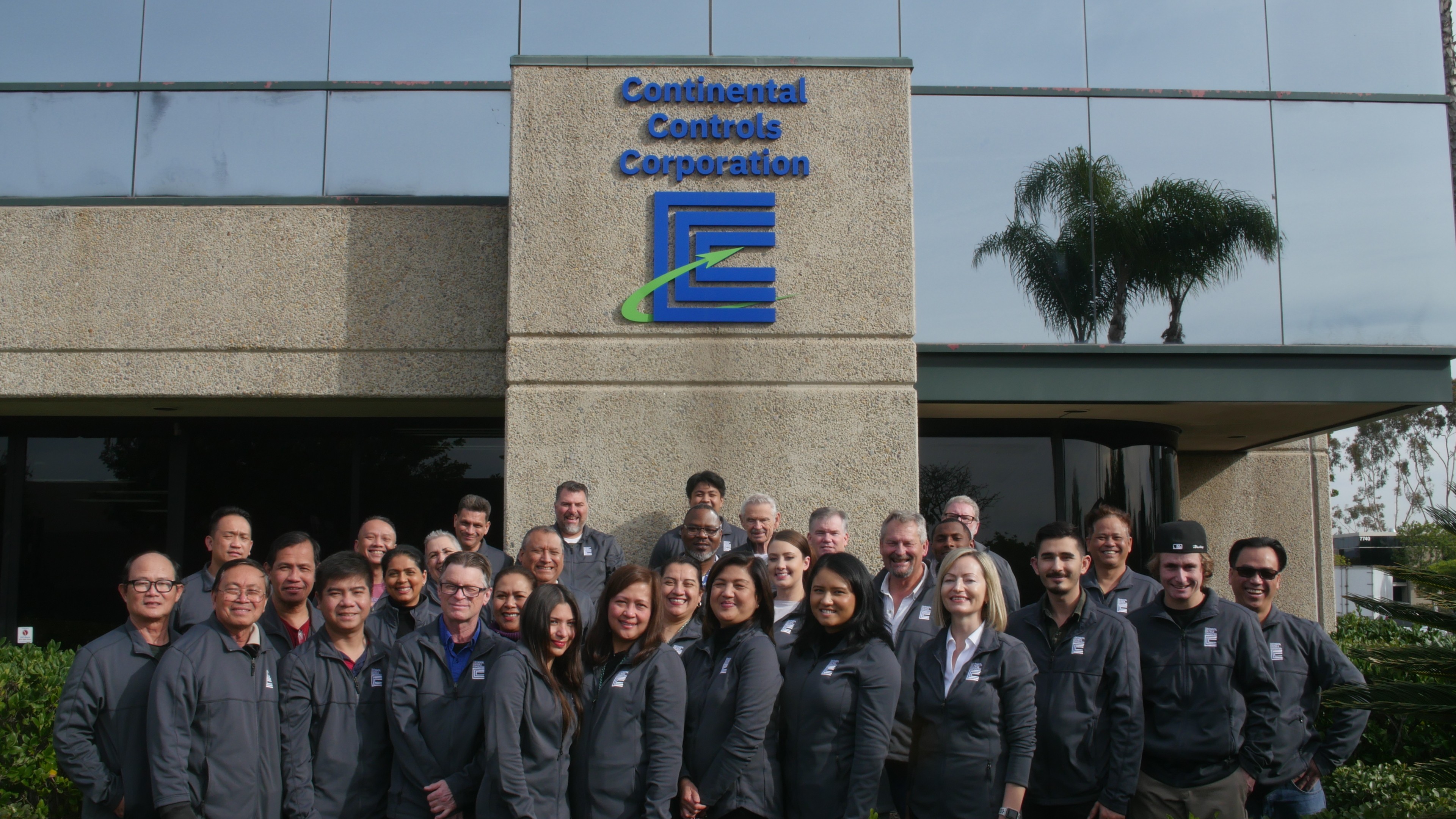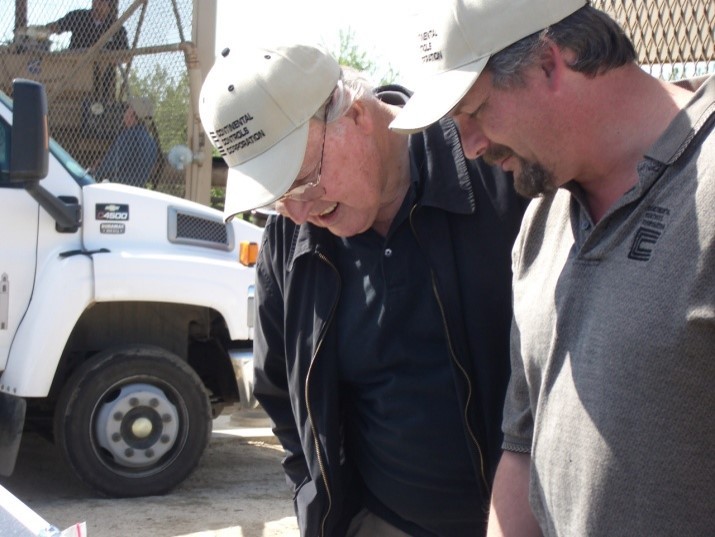
About
Our Mission
Working to optimize control, mixing and efficiency of natural gas for any application, while minimizing emissions.
Our Vision
Our vision is to treat every customer, large and small, as though their success is our success. We learn through every customer or application interaction. Our pragmatic approach to serving our customers will result in winning applications, which will benefit both the customer and CCC.
Continental Control's History
Ross Fisher and George Mansfield are responsible for the development of the earliest electronic fuel control valves for CCC. In about 1969, CCC had taken on a new project to redesign “Black Boxes” for Solar Gas Turbines to improve reliability in the boxes. Ross’ long time friend and brilliant electronic engineer, Bill Pickett, was also instrumental in the design of the Black Boxes. Also about this time, George Mansfield began working on a liquid fuel metering valve that was actuated by a primitive solenoid with very crude approximations in its magnetic design. The black box array, along with the solenoid actuated valve, comprised the first step taken by these two gas turbine control pioneers.
1968-1970 (approximate)
Designed and prototyped a liquid control valve with features including a built-in metering valve that was actuated by a primitive solenoid, using crude approximations in its magnetic design. This, with the Black Box controls, provided a complete turbine control system.
1972-1974
Around 1972, Ross and George again collaborated to develop a new electronic valve with much more precise magnetics. This solenoid had four times the force of the first design in the same package size. This new valve design and the recently completed analog, black box series, provided a complete system for startup, and designed and produced a much more advanced liquid valve. More precise magnetic analysis produced as solenoid with 4 times the force of the first design for the same power and package size. Overall packaging made the valve much smaller and compatible with engine manufacturers fuel systems. Valve and analog electronic modules provided a complete system for control of startup, acceleration, governing and shutdown of the wildly successful, Solar standby power generator (“KS Sets”). This valve was in production throughout the 70s by CCC and beyond well into the 80s after being CCC was acquired by Bendix Corporation.
1974-1978
CCC extended the stroke of its seated solenoid for use as drive of a large, balanced double poppet valve as the heart of a new gaseous fuel valve for gas turbines in the 500-3000 HP range.
CCC engineering also made its first steps in developing digital computer-controlled valves. However, the primitive embedded hardware of the time made its response too slow for handling rapid engine load transients.

Picture above of George Mansfield in the 1970s
1979
Bendix South Bend Fuel Controls Division acquired CCC to expand its aircraft product line, adding CCC’s proven industrial fuel control product line. Ross Fisher stayed on for Bendix as the VP/Chief Engineer of CCC/Bendix Industrial Controls Division. Bendix engine ignition hardware also became part of the product mix with a complete ignition package for industrial engines known as the BASIC system.
1989
Bendix decided to sell off the group in San Diego and it was split between Ross Fisher and Precision Engine Controls, with Ross Fisher keeping the CCC name and the Black Box products.
1992-1994
After Ross Fisher acquired rights to the CCC corporate name and restarted the company with a vision of producing an advanced line of embedded computer, liquid and gas fuel valves and control systems.
George Mansfield was “rehired” as engineering design consultant.
The first prototype gas valve used a “Welker” pressure actuated elastomeric sleeve valve with voice coil driven flapper pilot valve to provide sleeve-valve “squeeze “pressure on the Welker sleeve to control its metering area.
This was CCC’s first use of voice coils, using at first, commercial units, then designing their coils own based on more advanced magnetic analysis software which was unavailable in the 1970’s.

Ross Fisher at the first CCC Turbine Control System about 2000
1992-2000
Several additions were made to the CCC staff. First hiring son David Fisher, who had pragmatic experience in embedded systems from designing for Tektronix in Oregon. David moved south to San Diego to join the team.
George had become a professor at SDSU in Mechanical Engineering and he would help steer some of his best students to CCC. Upon graduation, Kris Yates (one of George's top students), came on board and with Ross, George and Dave, designed CCC’s first computer-controlled fuel control gas valve with built-in flow measurement, the AGV-10. It featured a voice coil/flapper valve pilot controlling pressure on a large diaphragm-operated poppet valve. Kris became CCC’s Chief M.E. until retirement in 2019.

David and Ross around 2010
200(1)-2010
The AGV10 was followed by the AGV50 for large engines.
Voice coils became the actuator for all CCC valves. The primary advantages were that they offered much longer linear stroke (which provides more precise control), required less power and provided more force in comparison to any solenoid actuator. Also advanced finite analysis software plus availability of high force rare earth magnets made it possible to design the very powerful direct-drive valve actuators used in CCC’s governor valves, electronic carburetors and the massive AGV100 gas valve for 50,000 HP engines.
2010-2020
In 2008, CCC was invited to head up a research program funded by the California Air Resources Board (CARB). For three years, CCC provided products, personnel, and testing for the project. This research uncovered specific requirements to effectively control, over an extended time, emissions reduction for Natural Gas Engines.

Rick Fisher with So. Cal Gas employees discussing the new research project 2009
The project with CARB concluded in 2012 with a long list of significant findings necessary to reduce emissions on large gas engines. These concepts included, more complete mixing of air and fuel, use of higher quality oxygen and NOx sensors in the control, the use of fast and accurate pressure control valves for varying AFR mix, venturis designed to create a proportional mix of fuel to air and many other advanced control concepts.
CCC’s new emissions control systems would be widely adapted for use on engines trying to meet rigorous emissions compliance requirements. In areas and states with very low emissions requirements, CCC’s products were often the only ones that could meet the more strenuous requirements.
By 2016, CCC expanded its control product line to include very precise measurement of natural gas in a small package which included a venturi for a true mass flow calculation. The FM50 was the right product at the right time and has become widely adopted by gas utilities and pipelines for measuring fuel consumption on their individual engines and turbines.
About the same time, CCC introduced the Cat Monitor products, which interfaces with the O2 and NOx sensors and communicates the data to the ECV5 to provide a complete AFR system. It also monitors and stores data related to the health and operation of the Three Way Catalyst used to eliminate most emissions: NOx, CO, and non-methane hydrocarbons.
Video Overview
Address:
7710 Kenamar Ct.
San Diego, CA 92121
Phone
Contact Us
"*" indicates required fields